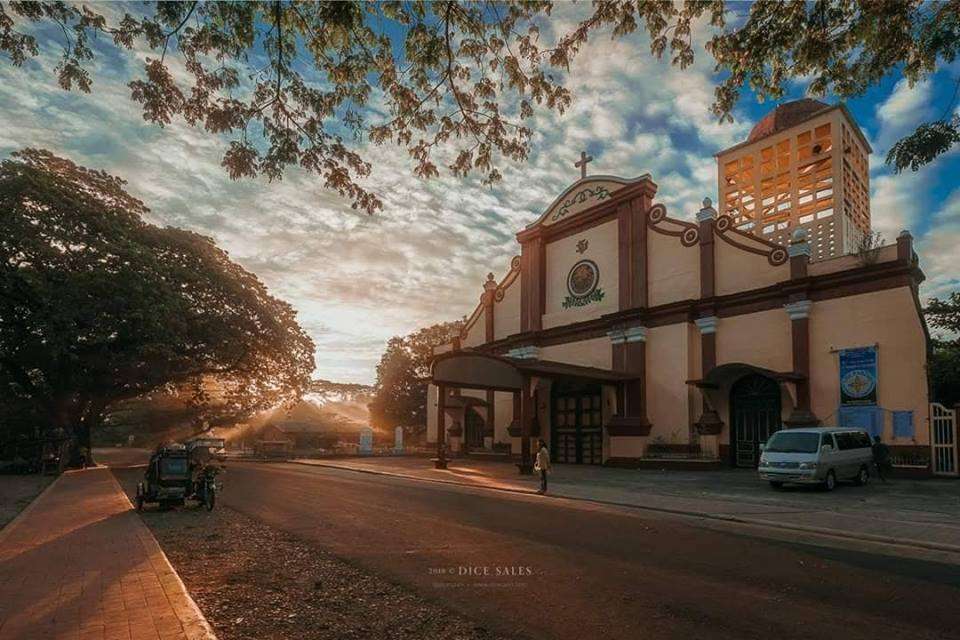Happy Easter, Binalonians! As we renew our devotion in the resurrection of our Lord, let us know more about one of the gems of Christian faith in our municipality, the Church of Sto. Nino in Binalonan. Here are snippets about the pristine church written by our resident historian Veronica Sison, from the forthcoming book on the “History of Binalonan” to be launched this 2019!
Photo credits to Mr. Dice Sales (https://www.facebook.com/dicesales/)
**************
The church of Sto. Nino in Binalonan was established in the year 1841 seven years after it was declared as an independent civil municipality from its mother town, Our Lady of Manaoag.
The first church and convent complex was built in the same location approved by Fr. Julian Ysaga. It was first constructed with light materials, furnished and completed between the years of 1854-1855 (along with accessories needed to preside a mass such as vasos sagradas, los libros and cubiertos).
Both church and the convent stood the test of time when it first suffered from natural calamities such as typhoons in 1879 and 1881, and a deadly earthquake whose epicenter traversed San Manuel and Binalonan in 1892.
During the revolutionary period, the church and convent also served as a cuartel for Binalonan forces serving under the flag of Spain. The height of revolt in Pangasinan on 1896 was fought between the Spanish loyalist forces against the Ilocano-Pangasinan Katipuneros under the command of Maramba, Del Prado, Quesada and Macabulos.
Binalonan and Dagupan served as a battleground between the Katipuneros and Spanish loyalists. The entire town suffered from a devastating fire across Poblacion area with casulaties. Meanwhile, the onset of the Filipino-American war, the convent became a hospital station for retreating American soldiers running after the troops of Aguinaldo en route to the mountains of the Cordilleras.
During the second world war, the Sto. Nino church and convent was occupied by the Japanese forces where they built the 350 man garrison and stockpiled arms and ammunition inside the two-story convent that extends from present-day Barcca to Rizal street. Garrisons were occupied by the advancing Japanese forces from the towns from which the USAFFE had retreated.
The Japanese troops utilized this strategic location and size of the church complex of Binalonan where they stocked deliverables and supply to the other areas of Luzon, such as La Union and as far as Benguet. The church then stopped operating as a religious ground. Fr. Pablo Evangelista served as the resident priest for quite some time, but in the year 1943 no mass was presided and few Binalonians were entering the grounds for spiritual practices for the following years.
In Binalonan, life under the Japanese occupation entails drudging work in exchange for almost nothing, much like other narratives during this dark period in the country’s history. Many Binalonians were employed to fix bridges, tunnels, and other menial works but were not paid for their service. Sometimes just a piece of canned good because Japanese themselves do not have much to eat and they rely on the resident’s supplies.
Mr. Rodolfo Ignacio, recalled that his father was employed to deliver arms and ammunition from Binalonan to Damortis, La Union using cariton (wagon) but only paid for “isang pirasong tinapa” (a small portion/apiece of smoked fish) in exchange of his service. Despite its demeaning nature, Filipinos could not say no to the officers as they may receive grueling consequences.
Upon the arrival of Japanese troops in Binalonan, grade schools ceased to operate for several months including the present day North Central School and South Central School, (previously known as Binalonan Intermediate School).Japanese officers replaced Filipino educators by opening lessons for children aged 7 and above. According to Virgilio Reyes, 86 years old Binalonan Senior Citizen officer who was born and raised in Binalonan, they were taught Japanese calisthenics known as Radio Taiso which were a daily requirement.
Japanese education prioritized elementary, and vocational education and emphasized anti-materialism and the love of labor, while more emphasis on the Japanese language and Japanese national anthem. These lessons were guided by a Japanese captain who wears civilian attire but the typical white polo and khaki shorts and conducts their session on the second floor of the convent of the Sto. Nino Church. After six months, the officers eventually allowed Filipino schools to operate.
When the American Forces arrived, the entire complex was decimated and burnt to the ground. The only surviving piece was the retablo (church altar) where the Holy Child was located. This occurrence was considered by Binalonians as miraculous in nature. On 1954 Christ the King raised funds to reconstruct the church . The campaign was successful in reconstructing and remodeling the old century church.
The convent may not have been built but it remained in the hearts of those who remembers.

